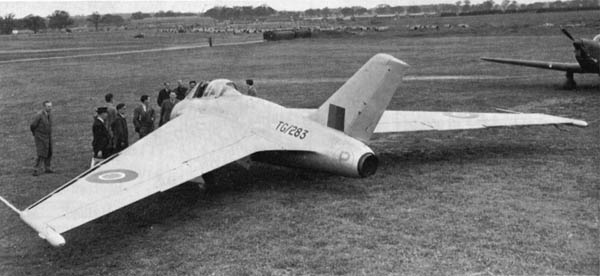John Carver Meadows Frost
The creative force behind the Avro Canada saucer projects was an engineer named John Frost.
Frost was born in Walton-on-Thames, in the western suburbs of London, on November 30, 1915. Like many boys his age, he fell in love with airplanes and aspired to become an aeronautical engineer. He entered St. Edwards College, Oxford, graduating in 1933, and went to work as an apprentice for the Airspeed company, a small sailplane builder.
He moved on, first to Miles Aircraft, then to Westland, which was building the famous Lysander STOL aircraft used during the war to infiltrate special agents into Nazi-occupied Europe. At Blackburn, another major airframe manufacturer, he helped build the company wind tunnel. In 1940, Frost was offered the opportunity to design a special large troop-carrying glider, called the Hengist, for Slingsby Sailplanes. One of the problems of assault glider design was the severe impact loads encountered during combat landing. Frost devised a unique belly-mounted airbag which would help attenuate the shock.
In 1942, he joined the design group at the prestigious de Havilland company, where he worked under the direction of chief designer R. E. Bishop. Bishop had built a distinguished career with the company, culminating with the development of the famous D.H. 98 Mosquito fighter-bomber. In 1941, the British government gave de Havilland the task of creating a high-performance single-engine fighter using the revolutionary new turbojet powerplant. Bishop's team designed an unusual-looking airframe around a fat, centrifugal-flow Halford engine. The jet's blunt fuselage contained only a tiny cockpit and the engine, and its short, straight wings supported two thin tailbooms tipped with small vertical fins. Young John Frost was responsible for designing the new jet's flaps, dive brakes and ailerons. First flown in September, 1943, the D.H. 100 Vampire, as it was called, debuted too late to be used operationally in World War II, but it was the world's first 500 mph fighter to enter service.

DH 100 Vampire prototype, 1943
In the immediate postwar period, after examining captured German data on the advantages of swept wings at transonic speeds, de Havilland decided to modify a Vampire into a completely new configuration, eliminating the tail booms and horizontal stabilizer and replacing the straight wing with new, highly swept surfaces. The revised aircraft, designated D.H. 108 (sometimes called the Swallow), was based heavily on Lippisch's Messerschmitt Me 163 Komet and a successor project, the jet-powered, tailless Me P. 1111 fighter, and was planned as an aerodynamic testbed for a large, four-engine turbojet airliner, the D. H. 106 Comet , with which de Havilland hoped to capture the expected post-war air travel market. Frost, one of the youngest designers in the company, was made project engineer on the D.H. 108, and his group began work on the experimental plane in October, 1945. When the D.H. 108 emerged from its hangar the next spring, it was a sleek, lithe creation, now almost a flying wing and completely transformed from its Vampire configuration.

DH 108 prototype, 1946
The prototype was trucked to a little-used RAF field at Woodbridge, Suffolk, and on May 15, 1946, test pilot Geoffrey de Havilland, son of the company's founder, lifted the D.H. 108 off for its first flight. It was only the second swept-wing jet to fly (the Horten Ho 9 having been the first). Early concern about instability caused by the novel wings was soon replaced by elation over the stellar handling qualities of the fighter. A second prototype was equipped with an uprated engine, wings with even greater sweepback, and hydraulic-powered controls to cope with high aerodynamic forces expected at supersonic speeds. Starting its tests in late August, 1946, the number two aircraft soon unofficially beat the world's speed record, easily exceeding 600 mph in level flight, and plans were made for a formal attempt on the record. On September 27, 1946, as Geoffrey de Havilland was diving D.H. 108 number two from high altitude in a test over the Thames estuary, the aircraft experienced severe vibration near the speed of sound and disintegrated, killing the noted test pilot. In spite of the tragedy the firm was committed to the project and immediately embarked on yet a third version of the design, incorporating a still more powerful engine and improved aerodynamics. Making its first flight on July 24, 1947, D.H. 108 number three soon showed its superiority. On September 9, 1948, test pilot John Derry climbed the aircraft to 40,000 feet and pushed over into a steep dive. A few moments later, the plummeting D.H. 108 became the first British aircraft to exceed Mach 1.
But by the time his creation entered the record books, John Frost had left the bleak world of post-war England for a new start in Canada. On June 14, 1947, ten days before Kenneth Arnold's Mt Rainier encounter with a formation of flying saucers, Frost had arrived in Toronto to join a rising new aircraft company called Avro.